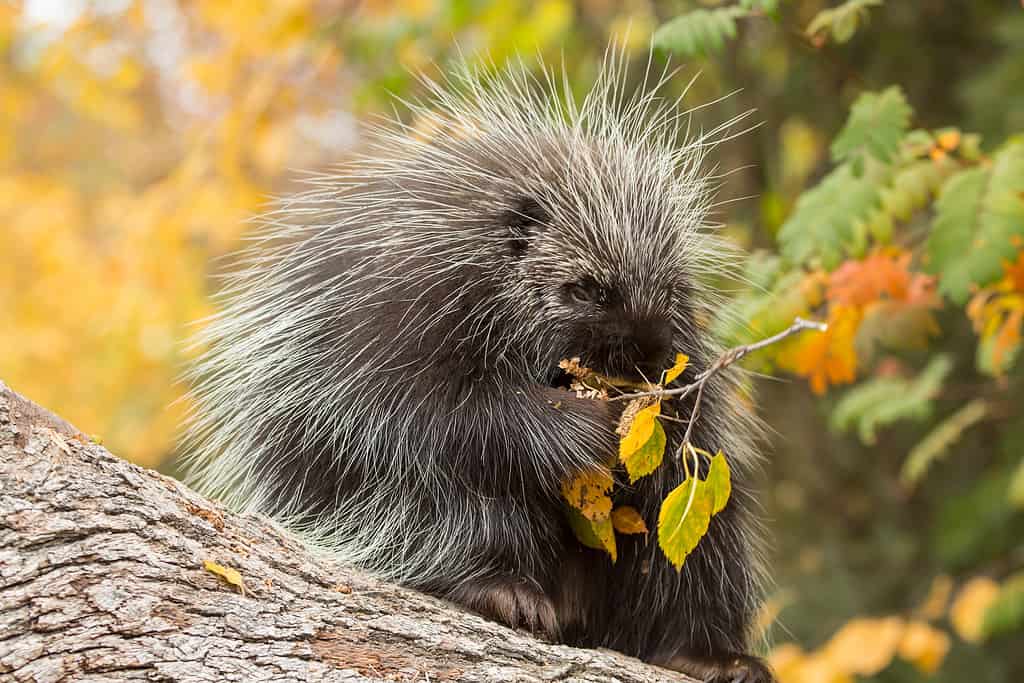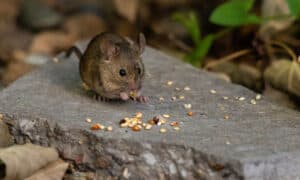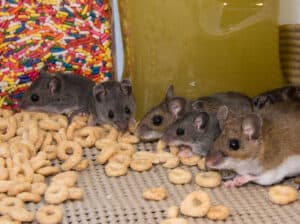Porcupine can refer to any of 58 species of rodents within the families Erethizontidae and Hystricidae. Porcupines range from 14-36 inches (36-91 cm) in length and weigh between 2-66 pounds (1-30 kg). These spiny herbivorous rodents are known for their quills, but a porcupine’s teeth are just as fascinating! Thanks to their iron content, a porcupine’s incisors (front teeth) are orange-to-red. Unlike most mammals, porcupines lack canines. Instead, they have modified incisors that grow constantly throughout their life. Let’s jump in and take a closer look at porcupine teeth!

The incisors are designed for cutting and gnawing tough plant material like bark, twigs, and leaves.
©Warren Metcalf/Shutterstock.com
What Kind of Teeth Do Porcupines Have?
Porcupine teeth are adapted for their herbivorous diet. Their front teeth, known as incisors, are large and constantly growing throughout their lifetime. These incisors are designed for cutting and gnawing tough plant material like bark, twigs, and also leaves. Porcupine incisors are orange-to-red in color thanks to their high iron content. The iron is incorporated into the enamel layer during tooth development, giving these teeth their characteristic rusty color. The presence of iron pigments in the incisors of these rodents is believed to add to their strength and durability.
In addition to their incisors, porcupines also have premolars and molars in the back of their mouth that are used for mashing and chewing their food. These teeth are flat and ridged, which helps them break down tough plant fibers.
Porcupine teeth are made up of different layers of tissue. The outside layer of the tooth is enamel, which is the hardest part of the body. Beneath the enamel is the dentin layer. Dentin is a hard, dense tissue that makes up most of the tooth structure. Dentin is also mineralized but is less hard than enamel. The inside part of the tooth is the pulp, which contains nerves, blood vessels, and connective tissues that provide nutrients and sensation to the tooth. However, porcupine teeth have evolved to be strong and durable for gnawing on tough plant material. Their teeth have adapted to the abrasive nature of their diet, which is why their incisors are constantly growing and have a thick layer of enamel to protect against wear and tear.
Porcupette Milk Teeth
Baby porcupines, called porcupettes, are born without teeth. Their first teeth, also known as milk teeth, begin to emerge during the first few weeks of life. The timing of their teeth coming through varies slightly between individual porcupines and between species. Generally speaking, the incisors are the first to emerge, followed by the premolars. By the time porcupettes are 2-4 months old, all of their deciduous teeth should have erupted.
Porcupettes have one pair of upper and one pair of lower incisors, for a total of four deciduous incisors. These teeth are used for gnawing and cutting plants. They have three pairs of upper and lower premolars, for a total of 12 deciduous premolars. These teeth are used for grinding and crushing food. The deciduous teeth will be replaced by permanent teeth beginning around six months of age. By the time the porcupine is one year old, it should have a full set of permanent teeth.
Porcupine Permanent Teeth
Porcupines have a total of 20 permanent teeth. They have 4 incisors, 4 premolars and 12 molars. These teeth are evenly apportioned between the upper and lower jaws. As with their deciduous teeth, the incisors are for cutting and gnawing on vegetation. The premolars and molars are for grinding, crushing, and chewing their food. A porcupine’s incisors never stop growing. This adaptation helps porcupines maintain their ability to gnaw and chew tough plant material throughout their lifetime. It also necessitates gnawing on bark and wood to keep these teeth at a manageable and practical length. Porcupines have a pronounced diastema, or space, between their incisors and premolars. The porcupine uses this space to carry its food.
Porcupine Bite Force
Porcupines are herbivores and their teeth are designed to gnaw and chew tough plant material rather than to deliver a powerful bite. However, their incisors are strong enough to easily gnaw through wood and other hard objects. In general, porcupines are not aggressive animals and will only bite if threatened. Their bite is not considered dangerous to humans.
The photo featured at the top of this post is © Christian Musat/Shutterstock.com
FAQs (Frequently Asked Questions)
Do porcupines have predators?
Porcupines have few natural predators due to their sharp quills, which can make them difficult to attack. However, some predators have developed strategies for hunting porcupines. For example, fishers (Pekania pennanti) , a type of weasel found in North America, are known to be skilled at attacking porcupines by biting them in the face, where the quills are less dense. Other predators of porcupines include coyotes, wolves, bobcats, and cougars.
Where do porcupines live?
Porcupines are found in many parts of the world, including Asia, Africa, Europe, and the Americas. In North America, they are found throughout much of Canada, the United States, and Mexico, with the exception of the southeastern United States. Porcupines are also found in South America. They live in a variety of habitats, from forests and grasslands to deserts and rocky outcroppings. Some species of porcupines, such as the North American porcupine, are arboreal and spend most of their time in trees, while others are ground-dwelling.
Can porcupines get rabies?
Porcupines can potentially contract and transmit rabies. However, they are not considered a primary carrier of rabies and are not known to be a significant risk to humans or other animals. In general, porcupines are not aggressive towards humans unless they feel threatened or cornered, and they are more likely to try to flee than to attack.
Are porcupines nocturnal?
Porcupines are generally considered to be nocturnal animals, meaning they are most active at night. They are well adapted to living in the dark. They have good night vision, which helps them navigate their surroundings and find food. During the day, porcupines may rest in trees or other sheltered locations, which can make them difficult to spot.
What is the conservation status of porcupines?
The conservation status of porcupines varies depending on the species and the region. Some species of porcupines are considered to be of least concern by the International Union for Conservation of Nature (IUCN), meaning they are not currently at risk of extinction. However, other species are listed as vulnerable or endangered due to habitat loss, hunting, and other threats.
Thank you for reading! Have some feedback for us? Contact the AZ Animals editorial team.






